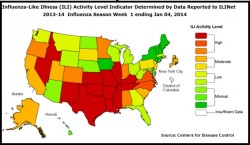 With this year’s flu season already widespread and, in some areas, turning increasingly deadly, employers are being urged by OSHA to encourage their sick workers to stay home.
With this year’s flu season already widespread and, in some areas, turning increasingly deadly, employers are being urged by OSHA to encourage their sick workers to stay home.
Now deemed widespread in 35 states, and regionally extensive in several more, this season’s influenza outbreak has not yet reached the pandemic stage, but, says the Occupational Safety and Health Administration, if the flu outbreak of 2009 is any guide, most workplaces will not be ready if it does.
That year, as the swine flu was spreading (the same strain now affecting the U.S.), Dr. John Sullivan posted a 20-point checklist for businesses. As relevant now, as it was then, his list covers much of the same territory, but far more directly, than does an OSHA pamphlet.
The government’s guidance includes a number of tips, advice on how to minimize exposure (lots of hand washing), and recommends that businesses prepare a plan in case the influenza outbreak does grow into a serious pandemic. If that should occur — and that seems unlikely at this point — OSHA says as much as 40 percent of the workforce could be affected.
“Develop a sick leave policy that does not penalize sick employees,” counsels OSHA.
As wise as that advice may be, most employees have come to work when sick. A number of surveys and studies over the years have documented the prevalence of ‘presenteeism,’ most recently a survey by Staples. The office supply company’s annual survey found 90 percent of workers come to work sick, a sharp increase over previous Staple’s surveys. In the 2011 survey, 60 percent said they come to work sick. In 2012, the percentage reached 80.
The No. 1 reason given for coming to work sick, according to the survey, was not wanting to fall behind on work. With fewer workers now than just a few years ago, individual workloads have grown. However, there’s more than enough evidence to show that sick workers are far less productive than healthy ones. Staples says productivity can drop as much as 40 percent. One of the most extensive studies done on the subject of presenteeism (in 2004) put the price of being sick at work at an average of $255. Respiratory infected workers who came in even when they were sick cost employers $134. The cost today, simply due to inflation, would be higher.
Not surprisingly, many types of healthcare workers are required to be vaccinated annually and, should they become ill, may even be ordered to stay away until they are no longer contagious. Those who refuse have been fired; last year eight employees at Indiana University Health were terminated. This year, Horizons Healthcare Services fired a pregnant nurse for refusing a flu shot.
Although these cases all involve healthcare workers, employment attorney Bryan Cavanaugh, quoted by CBS News, says other employers could require workers to get vaccinated as a condition of employment. The only exceptions might be those with a medical condition and those with religious objections.